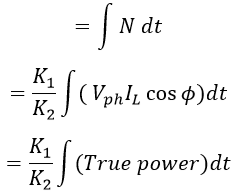An electrical measuring instrument used to measure the energy consumption of a load is called an Energy Meter. The measurement of electrical energy consumption by the various domestic and industrial loads is very important from the economic point of view.
The electrical energy utility by the load is basically power consumed over a period of time. If the time interval is in hours, then the energy measurement is in Watt-hours. Most of the energy meters measures in the unit of Kilowatt-hours (kWh).
Generally, energy meters are integrating meters that can record power utilized by the load for a particular interval of time. There are various types of energy meters among induction type energy meter are most popular can be used for ac measurements only. Depending upon the supply available there are two types of induction type energy meters.- Single Phase Induction Type Energy Meter
- Three Phase Induction Type Energy Meter
In this let us see about construction and working of single-phase induction type energy meter.
Construction of Single Phase Induction Type Energy Meter :
The constructional details of an induction type single-phase energy meter is shown below.
The meter consists of four major parts namely,- Driving system
- Moving system
- Braking system
- Registering system
Let us see in detail each and every part,
Driving System :
The driving system consists of two ac electromagnets namely, shunt magnet and series magnet which is magnetized proportional to supply voltage and load current respectively. Hence, the winding of the shunt magnet center limb is called a pressure coil and the winding of the series magnet is called a current coil.
The shunt magnet provides a low reluctance path through the small air gaps for the circulating fluxes (Φc1 and Φc2). So only a small amount of flux Φp flows through the central limb to the disc which is one of the operating flux. The second operating flux Φs is produced by series magnet.
The flux Φp should be exactly in quadrature (i.e., 90° out of phase) with the supply voltage, but due to the resistance of the pressure coil and iron losses in magnetic circuit Φp will never be in quadrature with voltage which misleads the operation. So, in order to bring Φp exactly in quadrature with supply voltage, copper-shading bands or rings are provided on the central limb of the shunt magnet whose resistance is adjustable.
Moving System :
This system consists of a lightweight aluminum disc that is mounted on a shaft and positioned in the air gap between the two magnets. The bottom of the shaft is pivoted into a jewel bearing and the top of the spindle provided with a simple sleeve pin-type bearing. The shaft also carries a pinion (gear) which connects the shaft to the registering mechanism.
Braking System :
This system is required to control the speed of rotation of the disc and also to bring the disc to an idle state when the load is disconnected, which is done by a permanent magnet called a braking magnet. This magnet is so placed in order to bring the disc in between the poles of the magnet.
Whenever the disc rotates, it cuts the field of the braking magnet and an emf is induced in it which makes eddy currents flow. This current set up a field in the disc, which opposes the main field and thereby reduces its magnitude. Hence, the braking torque (which opposes the rotation of the disc) is produced.
Registering System :
Registering system (a mechanism) is also known as the counting system (a mechanism). This system is engaged with the pinion, which is a gear mounted over the shaft of the disc. The mechanism consists of a train of gears.
Since the number of rotations of the disc is proportional to the power consumption, the gear-turn ratio is selected so as to rotate the indicators on the panel to indicate the total energy consumed. The gear-turn ratio between the adjacent indicators will be 10:1 so that the energy consumed is integrated up to thousands of kWh.
Working of Single Phase Induction Type Energy Meter :
When the load is not connected, no flux is produced in the series magnet and only a shunt field is present. This alternating flux Φp links with the disc and induces an emf Ep in the disc, due to this emf an eddy current Ip flows in the disc, which produces an alternating field Φp' in the disc. But, no torque will be produced in the disc due to these two fluxes, because both the fluxes are 180° out of phase.
When the load current IL flows through the current coil, the series magnet is magnetized and an alternating flux flows through it, and this flux links with the disc, which also produces an emf Ese resulting in the flow of eddy current Ise. Ise sets up a field Φse' in the disc which interacts with the field due to Ip and hence torque is produced in the disc due to this interaction of both the fields. The torque produced is proportional to the difference of the torques due to Ip and Ise.
The phasor diagram of the energy meter is shown below.
Therefore, average torque is given as,
But,Ip ∝ Φp ∝ VphIse ∝ φse ∝ ILFrom this,Since A + B is a constant,T ∝ Vph IL cosΦ
From the above, the average torque produced in the disc is proportional to the actual power consumed in the load.
The above equation is derived assuming that Φp lags behind Vph by exactly 90°. So, if Φp is not exactly in quadrature with Vph the above relation fails. Hence the copper shading rings or bands must be provided to hold the above relation good. Let the torque produced by the braking magnet be TB. TB will be proportional to the speed of the disc (i.e., N).








